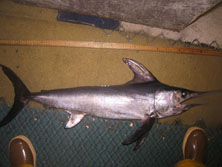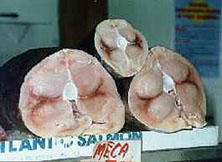North Pacific Swordfish (Xiphias gladius)
- Populations of swordfish in the Pacific are very healthy. Pacific swordfish is not overfished and overfishing is not occurring.
- Management measures have prohibited longline fishing in the West Coast EEZ and shallow-set longlining in the high seas and established restrictions for the longline fishery in Hawaii to reduce impact on endangered sea turtles.
- Swordfish is an excellent source of selenium, niacin, and vitamin B12 and a good source of zinc. Swordfish may contain amounts of methylmercury in excess of the FDA's recommended limit for moms, moms-to-be, and young children. For more information, see EPA and FDA advice on what you need to know about mercury in fish and shellfish.
- The Hawaii-based longline fishery is the largest producer of swordfish of all the U.S. North Pacific swordfish fisheries. Hawaii-based longliners account for about two thirds of U.S. swordfish production and about 15% of all Pacific swordfish landings.
|
 |
 |
 |
 |
| Nutrition Facts |
| Servings 1 |
| Serving Weight
100g |
 |
| Amount Per Serving |
 |
| Calories 121 |
 |
| Total Fat |
4.01 g |
 |
| Total Saturated Fatty Acids |
1.097 g |
 |
| Carbohydrate |
0 g |
| Sugars |
0 g |
| Total Dietary
Fiber |
0 g |
 |
| Cholesterol |
39 mg |
 |
| Selenium |
48.1 mcg |
 |
| Sodium |
90 mg |
 |
| Protein |
19.8 g |
 |
|
 |
 Scientists from the Pacific Islands Fisheries Science Center are conducting research on the spawning activity of billfishes. During research cruises, scientists tow a net through the surface waters to collect the minute eggs and larvae produced by spawning adults. They can then learn more about which billfish species are spawning in the area, observe when and where the eggs and larvae occur, and determine if spawning is associated with environmental conditions like water temperature and salinity. Above is a 3-inch long larval swordfish caught in a sampling net. Scientists from the Pacific Islands Fisheries Science Center are conducting research on the spawning activity of billfishes. During research cruises, scientists tow a net through the surface waters to collect the minute eggs and larvae produced by spawning adults. They can then learn more about which billfish species are spawning in the area, observe when and where the eggs and larvae occur, and determine if spawning is associated with environmental conditions like water temperature and salinity. Above is a 3-inch long larval swordfish caught in a sampling net.
|
 |
Did you know?
Swordfish have specialized tissues that warm the brain and eyes allowing them to successfully forage at great depths in frigid waters.
The International Game Fish Association's all tackle angling record for swordfish is a 1,182-pound fish taken off Chile in 1953.
In the Hawaiian longline fishery, fishing gear is set at night with luminescent light sticks which are used to attract swordfish or their prey.
|
|
| |
 |
|
Measuring a swordfish. Swordfish can reach a maximum size of 14 feet and almost 1,200 pounds. Females grow larger than males, as males over 300 pounds are rare.
|
 |
|
Swordfish steaks at the market. Almost all of the swordfish landed in Hawaii are exported to the U.S. mainland; therefore, landings in Hawaii are partly dependent on the market for swordfish on the U.S. mainland.
|
|
Sustainability Status
Biomass: The biomass of North Pacific swordfish is 75% above the biomass needed to support maximum sustainable yield.
Overfishing: No
Overfished: No
Fishing and habitat: Within the Hawaii EEZ, swordfish are caught on longlines and handlines. Off the West Coast, small amounts of swordfish are harvested using drift gillnets and hand-held harpoons. These gear types have minimal adverse effects on habitat.
Bycatch: Marine mammals, seabirds, and sea turtles can be incidentally caught in gillnet and pelagic longline fisheries. Longliners in Hawaii operate under strict regulations aimed at reducing the take of sea turtles when targeting swordfish. The regulations include species specific sea turtle take limits, limit on effort, change in gear and technology (circle hooks, mackerel or mackerel-type baits, night setting) and 100% observer coverage. Researchers from NOAA Pacific Islands Fisheries Science Center, several universities, and other organizations are studying ways to further reduce impacts of bycatch in longline fisheries in Hawaii. The bycatch studies are aimed at finding new ways to modify longline gear in order to reduce the harm to non-target species, while maintaining a commercially viable fishery. All longline fishing is prohibited in the U.S. West Coast EEZ, and shallow-set longline fishing is prohibited on the high seas. Measures to protect sea turtles from drift gillnets are also in effect.
Aquaculture: There is no commercial aquaculture of swordfish in the United States.
|
Science and Management
The Pacific swordfish fishery off the West Coast of the United States is managed by the Pacific Fishery Management Council through the Fishery Management Plan (FMP) for Highly Migratory Species (HMS). The HMS FMP currently prohibits West Coast longline fishermen from fishing in the Exclusive Economic Zone (EEZ) and shallow-set longline fishing on the high seas, unless they have a Hawaii longline limited entry permit and set certificates. New measures to protect sea turtles from drift gillnets were put in place in August 2001, and new monitoring requirements came into effect in April 2005. Commercial fishermen must obtain a permit from NMFS to fish for HMS and maintain logbooks documenting their catch. These measures are intended to improve data collection about HMS catches. The FMP also requires that a Stock Assessment and Fishery Evaluation (SAFE) Report be prepared each year to provide information about the status of HMS stocks and information about HMS fisheries.
The swordfish fishery in the EEZ off the Pacific Islands is regulated by the Western Pacific Regional Fishery Management Council through the FMP for Pelagic Fisheries of the Western Pacific Region. Amendment 3 to the FMP placed a moratorium on entry into the longline fishery in 1991, followed in 1994 by a limited entry program to restrict effort. Longline exclusion zones were established to prevent interactions with endangered Hawaiian monk seals in the Northwestern Hawaiian Islands and to prevent gear conflicts between smaller pelagic fishing boats. The Council has established a mandatory Vessel Monitoring System to enforce these zones. Hawaii-based longline vessels are also required to carry onboard observers when requested by NMFS, partly to record interactions with sea turtles, seabirds, and marine mammals. The swordfish segment of the longline fishery was closed from 2001 to 2004 due to concerns about the fishery's interactions with sea turtles. Hawaii longliners now operate under a regulatory framework mandating gear modifications and operating procedures, including limits on the number of sets they may make, to reduce the take of sea turtles when targeting swordfish. Turtle take caps were also established for the Hawaii longline fishery. The maximum annual limits on sea turtle interactions are 16 leatherback sea turtles and 17 loggerhead sea turtles; when either of these two limits is reached, the longline fishery is closed for the remained of the calendar year.
Since highly migratory species move throughout large areas of the Pacific and are fished by many nations and gear types, management by the United States alone is not enough to ensure that harvests are sustainable in the long term. Effective conservation requires international cooperation. The Inter-American Tropical Tuna Commission (IATTC) conducts most stock assessments to determine stock status. The Western-central Pacific Fisheries Commission (WCPFC) also helps foster international cooperation for the management of swordfish.
Both NOAA's Pacific Islands and Southwest Fisheries Science Centers conduct research on swordfish to better inform management of the species.
|
Life History and Habitat
Life history, including information on the habitat, growth, feeding, and reproduction of a species, is important because it affects how a fishery is managed.
- Geographic range: Swordfish are found worldwide in all tropical, subtropical, and temperate seas.
- Habitat: Swordfish are abundant near boundary zones where there are sharp gradients of temperature and salinity. They are also found in areas of high productivity where prey are abundant. Larvae are found in surface waters.
- Life span: Maximum age of at least 9 years.
- Food: Swordfish are voracious and opportunistic feeders at all life stages. Larval and young swordfish actively feed on zooplankton during the day and eat fish larvae as they grow larger. Larval swordfish are known to swallow prey as long as themselves. Adults feed on a wide range of squid, fish, and crustaceans. The fish they feed on include pelagic fish such as small tuna, dorado, barracuda, flying fish, and mackerel as well as benthic species such as hake and rockfish.
- Growth rate: Swordfish grow extremely fast during their first year of life and may reach 3 feet by one year of age. After two years of age, females tend to grow faster and to a larger size than males, and are proportionately heavier at the same length.
- Maximum size: 14 feet in length and 1,190 pounds in weight.
- Reaches reproductive maturity: At about 5 to 6 years of age, when they are about 5 to 5.5 feet in length.
- Reproduction: Swordfish most likely spawn more than once per season. A swordfish ovary contains hundreds of millions of eggs. Eggs are fertilized externally and float at the sea surface due to the presence of a single droplet of oil. They incubate for about 2.5 days.
- Spawning season: Swordfish do not seem to have a specific spawning season. Spawning occurs throughout the year in equatorial waters but is restricted to spring and summer at higher latitudes.
- Spawning grounds: Swordfish do not seem to have specific spawning grounds. They are believed to spawn close to the surface.
- Migrations: Little is known about migration of Pacific swordfish. Limited tagging data support a general west-east movement from Hawaii toward North America.
- Predators: Swordfish likely have few predators as adults, although juveniles are vulnerable to predation by large pelagic fish.
- Commercial or recreational interest: Both, although commercial fisheries account for the majority of the landings.
- Distinguishing characteristics: Swordfish are characterized by a long, flat bill in contrast to the smooth, round bill of marlins. Swordfish are elongate and round-bodied and lack teeth and scales as adults.
|
Role in the Ecosystem
Adult and juvenile swordfish feed at the highest levels of the food chain. This means they are not typically prey to other animals and are important in keeping the ecosystem in balance by consuming smaller fish and invertebrates.
|
Additional Information
Market name: Swordfish
Vernacular names: Broadbilled swordfish, Broadbill, Espada, Emperado, Shutome (Hawaii)
|
Biomass
Biomass refers to the amount of Pacific swordfish in the ocean. Scientists cannot collect and weigh every single fish to determine biomass, so they use models to estimate it instead. These biomass estimates can help determine if a stock is being fished too heavily or if it may be able to tolerate more fishing pressure. Managers can then make appropriate changes in the regulations of the fishery.
The status of swordfish in the Pacific is unclear and assessment results are often conflicting. However, results suggest that Pacific stock swordfish are relatively healthy and being fished at levels below maximum sustained yield although recent fishery statistics have not been available.
Landings
 Landings refer to the amount of catch that is brought to land. Landings from the U.S. swordfish fisheries in the North Pacific Ocean increased steadily from 1970 through 1989 but rose sharply in the early 1990s. The Hawaii-based longline fishery is the largest producer of swordfish of all the U.S. North Pacific swordfish fisheries. Hawaii-based longliners account for about two thirds of U.S. swordfish production and about 15% of all Pacific swordfish landings. Landings refer to the amount of catch that is brought to land. Landings from the U.S. swordfish fisheries in the North Pacific Ocean increased steadily from 1970 through 1989 but rose sharply in the early 1990s. The Hawaii-based longline fishery is the largest producer of swordfish of all the U.S. North Pacific swordfish fisheries. Hawaii-based longliners account for about two thirds of U.S. swordfish production and about 15% of all Pacific swordfish landings.
Note: U.S. commercial landings are shown in the graph.
Biomass and Landings
Are landings and biomass related? Landings are dependent on biomass, management measures in the fishery, and fishing effort.
Data sources:
Landings from NMFS Annual Commercial Landings Statistics using "SWORDFISH" as Species and "PACIFIC" and "HAWAII" as State
|
Important Dates
1987 – FMP for Pelagic Fisheries of the Western Pacific Region is implemented
1989 – Swordfish landings increase in Hawaii as vessels begin to successfully target swordfish
1991 – Federal moratorium caps the number of longline vessels in Hawaiian fishery at 167; number of active longline vessels peaks at 141, with 114 vessels fishing for swordfish as their primary or secondary target
1993 – Hawaiian landings peak at 5,942 metric tons
1993 – A Gulf Coast fish processor sets up at Ventura Harbor, California, to provide longline vessels with ice, gear, bait, fuel, and fish offloading and transportation services; consequently, longline vessels seeking an alternative to the Gulf of Mexico longline fishery, and precluded from entering the Hawaii fishery due to a limitation on the number of permits, begin arriving in southern California1994 – Amendment 7 to the Pelagics FMP replaces Hawaii longline moratorium with a limited entry program, limiting the fishery to 167 vessels
By 1995 – The group of vessels that came to California from the Gulf of Mexico in 1993 and 1994 leave the California-based fishery
1995 – Hawaiian landings decline to 2,726 metric tons
2000 – As the result of the case Center for Marine Conservation vs. NMFS, a federal district court issues an order directing NMFS to complete an environmental impact statement (EIS) to assess the environmental impacts of fishing activities conducted under the Pelagics FMP by April 1, 2001, and ordered restrictions and closures over millions of square miles of the Hawaii-based longline fishery's usual fishing grounds. These court-ordered closures essentially close the longline fishery in Hawaii from 2001-2004.
2001 – Targeting swordfish by the Hawaii-based longline fishery is prohibited and swordfish landings drop significantly
2003 – Supplement to the August 2003 FMP EIS prohibits longline fishing east of 150° W longitude pursuant to Endangered Species Act regulations
2004 – The Hawaii-based longline fishery for swordfish is reopened along with a suite of new regulations intended to reduce longline interactions with sea turtles; swordfish landings increase more than 6-fold the following year
2004 – The final rule for implementing the HMS FMP is implemented, effectively closing the West Coast high seas shallow-set longline fishery for swordfish
|
Notes and Links
General Information:
Pacific Islands Fisheries Science Center - Swordfish Longline Fishery
Southwest Fisheries Science Center - Swordfish Research
NMFS Sustainability Species Identification - Swordfish
Pacific Fishery Management Council Background on Highly Migratory Species
Managing Marine Fisheries of Hawaii & the U.S. Pacific Islands - Past, Present & Future - Pelagic Fisheries
Fishery Management:
Fishery Management Plan for U.S. West Coast Fisheries for Highly Migratory Species
Fishery Management Plan for Pelagic Fisheries of the Western Pacific Region
Stock Assessments:
Assessment of Swordfish in the Eastern Pacific Ocean
Status of West Coast Fisheries for HMS through 2006
|
| |
|



